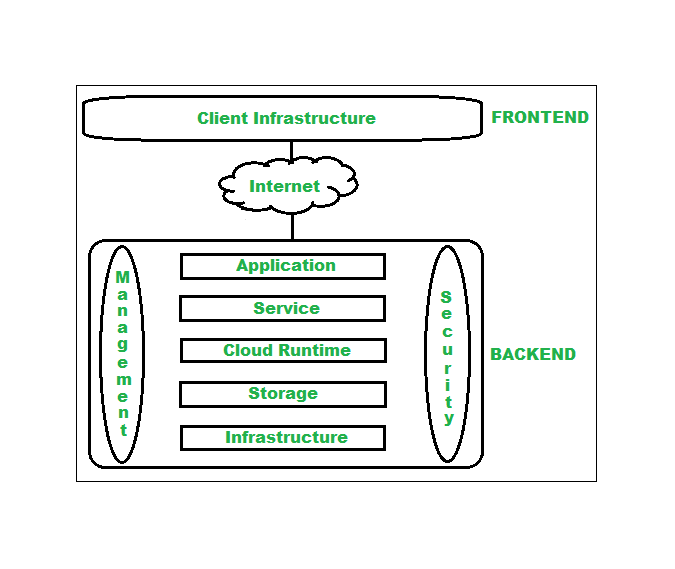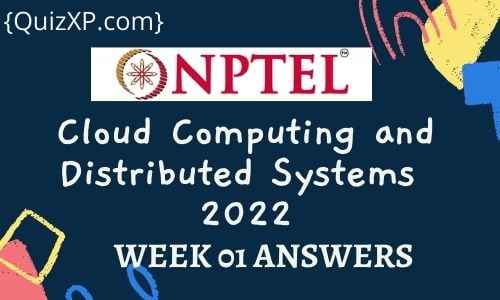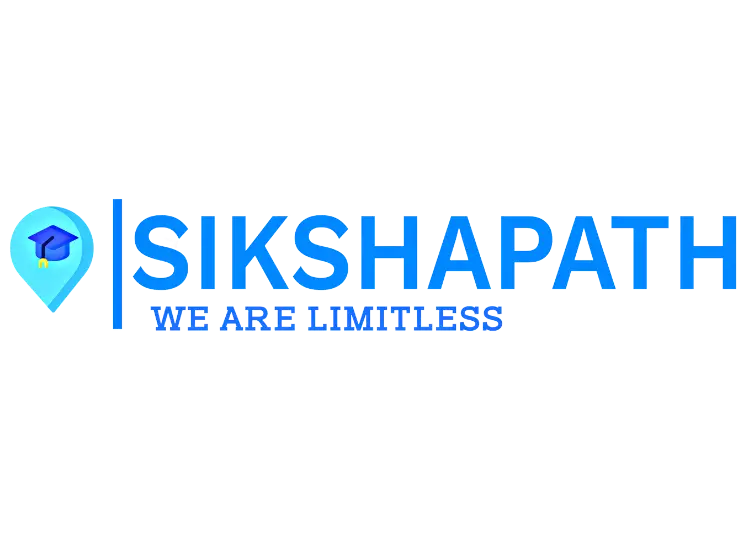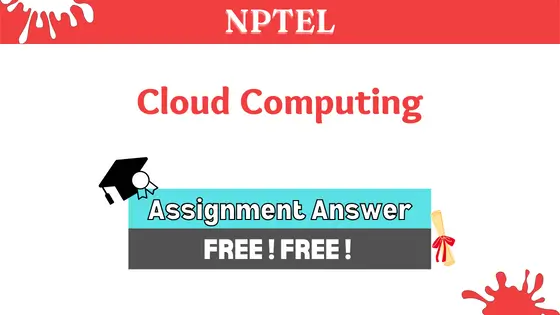Cloud Computing | Week 1
Session: JAN-APR 2024
Course Name: Cloud Computing
Course Link: Click Here
For answers or latest updates join our telegram channel: Click here to join
These are Nptel Cloud Computing Week 1 Assignment 1 Answers

Q1. Utility computing encapsulates the following characteristic(s) a) Mobility amalgamation b) No impact on resource utilization c) Pay-per-use pricing business model d) None of above
Answer: c) Pay-per-use pricing business model
Q2. In the context of the client-server architecture: Statement (i) posits that virtualization is a fundamental principle; Statement (ii) claims that the system has limited scalability. a) Only Statement (i) is correct b) Only Statement (ii) is correct c) Both Statements (i) and (ii) are correct d) None of the statements is correct
Answer: b) Only Statement (ii) is correct
Q3. A cluster is a type of ________ or distributed computing platform consisting of a collection of interconnected stand-alone computing computers working together in a ________ computing resource. a) computers, parallel b) single integrated, parallel c) node, parallel d) parallel, single integrated
Answer: d) parallel, single integrated
Q4. Dropbox is an example of: a) Software as a Service or SaaS b) Platform as a Service or PaaS c) Function as a Service or FaaS d) Infrastructure as a Service or IaaS
Answer: a) Software as a Service or SaaS
Q5. For less data-intensive applications, horizontal scale-out elasticity is the ideal solution. a) True b) False
Answer: b) False
Q6. The combination of Service-Oriented Infrastructure and Cloud Computing leads to ________. a) PaaS b) FaaS c) Serverless d) XaaS
Answer: d) XaaS
Q7. Utility computing is a service-provisioning model, in which a service provider makes computing resources and infrastructure management available to the customer. a) True b) False
Answer: a) True
Q8. Which of the following is false? a) Private cloud 1s dedicated solely to an organization. b) Community cloud is a composition of public and private cloud. c) Public cloud is available to the general public. d) None of these
Answer: b) Community cloud is a composition of public and private cloud.
Q9. Which of the following is one of the characteristics of PaaS? a) Provides tools to deploy user applications b) Application is provided by the cloud provider c) Resources are distributed as a service d) None of these
Answer: a) Provides tools to deploy user applications
Q10. Which of the following is/are a type of Grid? a) Computational Grid b) Data Grid c) Edge Grid d) All of the above
Answer: a) Computational Grid b) Data Grid
More Weeks: Click here
More Nptel Courses: Click here
Session: JULY-DEC 2023
These are Nptel Cloud Computing week 1 Assignment 1 Answers
Q1. Which of the following is a common property of distributed computing? A) Centralized control B) Fault tolerance C) Single point of failure D) Limited scalability
Answer: B) Fault tolerance
Q2. Peer-to-Peer computing resembles truly distributed applications. A) True B) False
Answer: A) True
Q3. Which of the following application(s) uses grid computing? A) Reactor Applications B) Air conditioning C) Crystallography D) Steganography
Answer: A, C
Q4. Which of the following is(are) a key component(s) of cluster computing? A) Parallel programming environment B) Single central processing unit C) Symmetric Multiprocessing (SMP) D) Node affinity
Q5. Utility computing is a ___ model, in which a service provider makes computing resources and _ available to the customer. A) service-provisioning, infrastructure management B) infrastructure management, service-provisioning C) cloud computing, resource management D) service-provisioning, resource management
Answer: A) service-provisioning, infrastructure management
Q6. Utility computing encapsulates the following characteristic(s) A) Mobility amalgamation B) Pay-per-use pricing business model C) No impact on resource utilization D) None of above
Answer: B) Pay-per-use pricing business model
Q7. In utility computing, the payment model differs for different customers based on scale and payment frequency alone. A) True B) False
Answer: B) False
Q8. What are the different characteristic(s) of cloud computing? A) Virtualization B) Service disagreement C) Service orientated D) Scalability
Answer: A, C, D
Q9. Google Spreadsheet is an example of : A) Platform as a Service or PaaS B) Software as a Service or SaaS C) Function as a Service of FaaS D) Infrastructure as a Service or Iaas
Answer: B) Software as a Service or SaaS
Q10. In the case of the client-server model: Statement (i) Virtualization is a core concept; Statement (ii) system can scale infinitely A) Only Statement (i) is correct B) Only Statement (ii) is correct C) Both Statements (i) and (ii) are correct D) None of the statements is correct
Answer: D) None of the statements is correct
Session: JAN-APR 2023
Q1) A distributed system is preferred when the task is : i)Data-intensive; ii)Computing-intensive A. Only (1) B. Only (ii) C. Both (i) and (ii) D. Neither (i) nor (ii)
Answer: C. Both (i) and (ii)
Q2) The “Grid” in the distributed grid computing paradigm links together power plants of different kinds. A. True B. False
Answer: B. False
Q3) Which one of the following is/are the advantage(s) of cloud computing? A. Resource pooling B. It requires an always-on internet connection. C. Ubiquitous D. On-demand payment policy
Answer: a, c, d
Q4) The distributed system ensures ‘robustness’ of performance. A. True B. False
Answer: A. True
Q5) What is (are) the characteristic(s) of using cluster computing? A. Parallel programming B. Faster network than a typical LAN C. Low-latency communication protocols D. None of these.
Answer: a, b, c
Q6) Web access to commercial software is one of the SaaS (Software as a Service) characteristics in the cloud computing paradigm. A. True B. False
Q7) Example(s) of PaaS (Platform as a Service) tool(s) is(are): A. Microsoft Powerpoint B. Microsoft Azure C. Google App Engine D. Google mail service
Answer: b, c
Q8) IaaS (Infrastructure as a Service) in cloud computing delivers (i) storage; (ii) servers. A. Only (1) B. Only (ii) C. Both (i) and (ii) D. Neither (i) nor (ii)
Q9) IaaS (Infrastructure as a Service) is the best option where regulatory compliance makes the offshoring or outsourcing of data storage and processing difficult A. True B. False
Q10) What is/are the main requirement(s) of a Cloud Service Provider (CSP)? A. Increase agility B. Increase cost C. Increase productivity D. Decrease cost
Answer: a, c
More From NPTEL: Click Here
Session: JULY-DEC 2022
Link to Enroll: Click Here
Q1. Which of the following fall(s) under the “essential characteristics” of cloud computing? a. Resource Pooling b. Measured Service c. Rapid Elasticity d. Latency
Answer:- a,b,c
Q2. “Google Slide” is an example of a. PaaS b. laaS c. SaaS d. FaaS
Q3. Which of the following is/are public cloud platform(s)? a. Windows Server Hyper-V b. Google Cloud Interconnect c. Amazon Virtual Private Cloud d. Microsoft Azure
Q4. VM technology allows multiple virtual machines to run on a single physical system. a. True b. False
Q5. Which one of the following is/are disadvantage(s) of cloud computing? a. Resource pooling b. It requires an always-on internet connection. c. Ubiquitous d. On-demand payment policy
Answer:- Update SOON
Q6. For less data-intensive applications, horizontal scale-out elasticity is the ideal solution. a. True b. False
Q7. The combination of Service-Oriented Infrastructure and Cloud Computing realizes to a. FTP b. SNTP c. XaaS d. FaaS
Q8. What is/are the main requirement(s) of a Cloud Service Provider (CSP)? a. Increase agility b. Increase cost c. Increase productivity d. Decrease cost
Answer:- a, c
Q9. PaaS (Platform as a Service) brings the benefits: (i) Creation of software (ii) Integration of web services and databases a. Only (1) b. Only (11) c. Both (1) and (ii) d. Neither (i) nor (ii)
Q10. A is a distributed computer system that consists of a collection of interconnected stand-alone computers working together as an integrated computing resource. a. Grid b. Cluster c. Cloud d. Node:


Cloud computing
Note: This exam date is subjected to change based on seat availability. You can check final exam date on your hall ticket.
Page Visits
Course layout, books and references.
1. Cloud Computing: Principles and Paradigms, Editors: Rajkumar Buyya, James Broberg, Andrzej M. Goscinski, Wiley,2011
2. Enterprise Cloud Computing - Technology, Architecture, Applications, Gautam Shroff, Cambridge University Press, 2010
3. Cloud Computing Bible, Barrie Sosinsky, Wiley-India, 2010
4. Cloud Security: A Comprehensive Guide to Secure Cloud Computing, Ronald L. Krutz, Russell Dean Vines, Wiley- India,2010
Instructor bio

Prof. Soumya Kanti Ghosh
Course certificate.

DOWNLOAD APP

SWAYAM SUPPORT
Please choose the SWAYAM National Coordinator for support. * :
- Trending Now
- Foundational Courses
- Data Science
- Practice Problem
- Machine Learning
- System Design
- DevOps Tutorial
- Cloud Computing Tutorial
Basics Of Cloud Computing
Cloud computing.
- History of Cloud Computing
- Evolution of Cloud Computing
Characteristics of Cloud Computing
- Top 7 Advantages of Cloud Computing
- Architecture of Cloud Computing
- Cloud Computing Infrastructure
- Cloud Management in Cloud Computing
- What is Cloud Storage?
- How Cloud Storage Actually Works !!
- Real World Applications of Cloud Computing
- Cloud Deployment Models
- Types of Cloud
- Difference Between Public Cloud and Private Cloud
- Public Cloud vs Private Cloud vs Hybrid Cloud
Cloud Service Models
- Cloud Based Services
- Platform As A Service (PaaS) and its Types
- Software As A Service (SaaS)
- Difference between IAAS, PAAS and SAAS
Cloud Virtualization
- Virtualization in Cloud Computing and Types
- Difference between Cloud Computing and Virtualization
- Pros and cons of Virtualization in Cloud Computing
- Data Virtualization
- Hardware Based Virtualization
- Server Virtualization
- Types of Server Virtualization in Computer Network
- Network Virtualization in Cloud Computing
- Operating system based Virtualization
Cloud Service Provider
- Amazon Web Services (AWS) Tutorial
- Microsoft Azure Tutorial
- Google Cloud Platform Tutorial
Advanced Concepts of Cloud
- On Premises VS On Cloud
- Differences between Cloud Servers and Dedicated Servers
- Cloud Networking
- Server Consolidation in Cloud Computing
- Hypervisor Security in Cloud Computing
- Cloud Computing Security
- Security Issues in Cloud Computing
- 7 Privacy Challenges in Cloud Computing
- Security Threats in Implementing SaaS of Cloud Computing
- Multitenancy in Cloud computing
- Middleware in Grid Computing
- Difference between Cloud Computing and Grid Computing
- Scalability and Elasticity in Cloud Computing
- Cloud Bursting vs Cloud Scaling
- Automated Scaling Listener in Cloud Computing
- Difference Between Multi-Cloud and Hybrid Cloud
- Difference Between Cloud Computing and Fog Computing
- Overview of Multi Cloud
- Service level agreements in Cloud computing
- Overview of Everything as a Service (XaaS)
- Resource Pooling Architecture in Cloud Computing
- Load balancing in Cloud Computing
- Overview of Desktop as a Service (DaaS)
- IoT and Cloud Computing
- Container as a Service (CaaS)
- Principles of Cloud Computing
- Resiliency in Cloud Computing
- Serverless Computing
Nowadays, Cloud computing is adopted by every company, whether it is an MNC or a startup many are still migrating towards it because of the cost-cutting, lesser maintenance, and the increased capacity of the data with the help of servers maintained by the cloud providers. One more reason for this drastic change from the On-premises servers of the companies to the Cloud providers is the ‘Pay as you go ’ principle-based services provided by them i.e., you only have to pay for the service which you are using. The disadvantage On-premises server holds is that if the server is not in use the company still has to pay for it.
What Is Cloud Computing?
Cloud Computing means storing and accessing the data and programs on remote servers that are hosted on the internet instead of the computer’s hard drive or local server. Cloud computing is also referred to as Internet-based computing, it is a technology where the resource is provided as a service through the Internet to the user. The data that is stored can be files, images, documents, or any other storable document.
The following are some of the Operations that can be performed with Cloud Computing
- Storage, backup, and recovery of data
- Delivery of software on demand
- Development of new applications and services
- Streaming videos and audio
What is Virtualization In Cloud Computing?
Virtualization is the software technology that helps in providing the logical isolation of physical resources. Creating logical isolation of physical resources such as RAM, CPU, and Storage.. over the cloud is known as Virtualization in Cloud Computing. In simple we can say creating types of Virtual Instances of computing resources over the cloud. It provides better management and utilization of hardware resources with logical isolation making the applications independent of others. It facilitates streamlining the resource allocation and enhancing scalability for multiple virtual computers within a single physical source offering cost-effectiveness and better optimization of resources.
To know about this refer this Article – Virtualization in Cloud Computing and Types
Architecture Of Cloud Computing
Cloud computing architecture refers to the components and sub-components required for cloud computing. These components typically refer to:
- Front end ( Fat client, Thin client)
- Back-end platforms ( Servers, Storage )
- Cloud-based delivery and a network ( Internet, Intranet, Intercloud )
Front End ( User Interaction Enhancement )
The User Interface of Cloud Computing consists of 2 sections of clients. The Thin clients are the ones that use web browsers facilitating portable and lightweight accessibilities and others are known as Fat Clients that use many functionalities for offering a strong user experience.
Back-end Platforms ( Cloud Computing Engine )
The core of cloud computing is made at back-end platforms with several servers for storage and processing computing. Management of Applications logic is managed through servers and effective data handling is provided by storage. The combination of these platforms at the backend offers the processing power, and capacity to manage and store data behind the cloud.
Cloud-Based Delivery and Network
On-demand access to the computer and resources is provided over the Internet, Intranet, and Intercloud. The Internet comes with global accessibility, the Intranet helps in internal communications of the services within the organization and the Intercloud enables interoperability across various cloud services. This dynamic network connectivity ensures an essential component of cloud computing architecture on guaranteeing easy access and data transfer.

Types of Cloud Computing
The following are the types of Cloud Computing:
- Infrastructure as a Service (IaaS)
- Platform as a Service (PaaS)
- Software as a Service (SaaS)
Infrastructure as a Service ( IaaS )
- Flexibility and Control: IaaS comes up with providing virtualized computing resources such as VMs, Storage, and networks facilitating users with control over the Operating system and applications.
- Reducing Expenses of Hardware : IaaS provides business cost savings with the elimination of physical infrastructure investments making it cost-effective.
- Scalability of Resources: The cloud provides in scaling of hardware resources up or down as per demand facilitating optimal performance with cost efficiency.

Platform as a Service ( PaaS )
- Simplifying the Development: Platform as a Service offers application development by keeping the underlying Infrastructure as an Abstraction. It helps the developers to completely focus on application logic ( Code ) and background operations are completely managed by the AWS platform.
- Enhancing Efficiency and Productivity: PaaS lowers the Management of Infrastructure complexity, speeding up the Execution time and bringing the updates quickly to market by streamlining the development process.
- Automation of Scaling: Management of resource scaling, guaranteeing the program’s workload efficiency is ensured by PaaS.
SaaS (software as a service)
- Collaboration And Accessibility: Software as a Service (SaaS) helps users to easily access applications without having the requirement of local installations. It is fully managed by the AWS Software working as a service over the internet encouraging effortless cooperation and ease of access.
- Automation of Updates: SaaS providers manage the handling of software maintenance with automatic latest updates ensuring users gain experience with the latest features and security patches.
- Cost Efficiency: SaaS acts as a cost-effective solution by reducing the overhead of IT support by eliminating the need for individual software licenses.
Function as a Service (FaaS)
- Event-Driven Execution: FaaS helps in the maintenance of servers and infrastructure making users worry about it. FaaS facilitates the developers to run code as a response to the events.
- Cost Efficiency: FaaS facilitates cost efficiency by coming up with the principle “Pay as per you Run” for the computing resources used.
- Scalability and Agility: Serverless Architectures scale effortlessly in handing the workloads promoting agility in development and deployment.
- To know more about the Types of Cloud Computing Difference please read this article – IaaS vs PaaS vs SaaS
- Private Deployment Model: It provides an enhancement in protection and customization by cloud resource utilization as per particular specified requirements. It is perfect for companies which looking for security and compliance needs.
- Public Deployment Model: It comes with offering a pay-as-you-go principle for scalability and accessibility of cloud resources for numerous users. it ensures cost-effectiveness by providing enterprise-needed services.
Hybrid Deployment Model
It comes up with a combination of elements of both private and public clouds providing seamless data and application processing in between environments. It offers flexibility in optimizing resources such as sensitive data in private clouds and important scalable applications in the public cloud.
To know more about the Cloud Deployment Models , please read this Articles
- Differences of Cloud Deployment Models
What Is Cloud Hosting?
The Infrastructure is where the people start and begin to build from the scratch. This is the layer where the cloud hosting lives. Let’s say you have a company and a website and the website has a lot of communications that are exchanged between members. You start with a few members talking with each other and then gradually the number of members increases. As time passes, as the number of members increases, there would be more traffic on the network and your server will get slow down. This would cause a problem. A few years ago, the websites are put on the server somewhere, in this way you have to run around or buy and set the number of servers. It costs a lot of money and takes a lot of time. You pay for these servers when you are using them and as well as when you are not using them. This is called hosting. This problem is overcome by cloud hosting. With Cloud Computing, you have access to computing power when you needed. Now, your website is put in the cloud server as you put it on a dedicated server. People start visiting your website and if you suddenly need more computing power, you would scale up according to the need.
- Scalability: With Cloud hosting, it is easy to grow and shrink the number and size of servers based on the need. This is done by either increasing or decreasing the resources in the cloud. This ability to alter plans due to fluctuations in business size and needs is a superb benefit of cloud computing, especially when experiencing a sudden growth in demand.
- Save Money: An advantage of cloud computing is the reduction in hardware costs. Instead of purchasing in-house equipment, hardware needs are left to the vendor. For companies that are growing rapidly, new hardware can be large, expensive, and inconvenient. Cloud computing alleviates these issues because resources can be acquired quickly and easily. Even better, the cost of repairing or replacing equipment is passed to the vendors. Along with purchase costs, off-site hardware cuts internal power costs and saves space. Large data centers can take up precious office space and produce a large amount of heat. Moving to cloud applications or storage can help maximize space and significantly cut energy expenditures.
- Reliability: Rather than being hosted on one single instance of a physical server, hosting is delivered on a virtual partition that draws its resource, such as disk space, from an extensive network of underlying physical servers. If one server goes offline it will have no effect on availability, as the virtual servers will continue to pull resources from the remaining network of servers.
- Physical Security: The underlying physical servers are still housed within data centers and so benefit from the security measures that those facilities implement to prevent people from accessing or disrupting them on-site.
- Outsource Management: When you are managing the business, Someone else manages your computing infrastructure. You do not need to worry about management as well as degradation.
- Benefits Of Cloud Computing
Top Reasons to switch from On-premise to Cloud Computing
Reduces cost.
The cost-cutting ability of businesses that utilize cloud computing over time is one of the main advantages of this technology. On average 15% of the total cost can be saved by companies if they migrate to the cloud. By the use of cloud servers businesses will save and reduce costs with no need to employ a staff of technical support personnel to address server issues. There are many great business modules regarding the cost-cutting benefits of cloud servers such as the Coca-Cola and Pinterest case studies.
More storage
For software and applications to execute as quickly and efficiently as possible, it provides more servers, storage space, and computing power. Many tools are available for cloud storage such as Dropbox, Onedrive, Google Drive, iCloud Drive, etc.
Employees Better Work Life Balance
Direct connections between cloud computing benefits, and the work and personal lives of an enterprise’s workers can both improve because of cloud computing. Even on holidays, the employees have to work with the server for its security, maintenance, and proper functionality. But with cloud storage the thing is not the same, employees get ample of time for their personal life and the workload is even less comparatively.
Top leading Cloud Computing companies
Amazon web services(aws).
- One of the most successful cloud-based businesses is Amazon Web Services(AWS), which is an Infrastructure as a Service(Iaas) offering that pays rent for virtual computers on Amazon’s infrastructure.
Microsoft Azure Cloud Platform
- Microsoft is creating the Azure platform which enables the .NET Framework Application to run over the internet as an alternative platform for Microsoft developers. This is the classic Platform as a Service(PaaS).
Google Cloud Platform ( GCP )
- Google has built a worldwide network of data centers to service its search engine. From this service, Google has captured the world’s advertising revenue. By using that revenue, Google offers free software to users based on infrastructure. This is called Software as a Service(SaaS).

Advantages of Cloud Computing
The following are main advantages of Cloud Computing:
- Cost Efficiency: Cloud Computing provides flexible pricing to the users with the principal pay-as-you-go model. It helps in lessening capital expenditures of Infrastructure, particularly for small and medium-sized businesses companies.
- Flexibility and Scalability: Cloud services facilitate the scaling of resources based on demand. It ensures the efficiency of businesses in handling various workloads without the need for large amounts of investments in hardware during the periods of low demand.
- Collaboration and Accessibility: Cloud computing provides easy access to data and applications from anywhere over the internet. This encourages collaborative team participation from different locations through shared documents and projects in real-time resulting in quality and productive outputs.
- Automatic Maintenance and Updates: AWS Cloud takes care of the infrastructure management and keeping with the latest software automatically making updates they is new versions. Through this, AWS guarantee the companies always having access to the newest technologies to focus completely on business operations and innvoations.
Disadvantages Of Cloud Computing
The following are the main disadvantages of Cloud Computing:
- Security Concerns: Storing of sensitive data on external servers raised more security concerns which is one of the main drawbacks of cloud computing.
- Downtime and Reliability: Even though cloud services are usually dependable, they may also have unexpected interruptions and downtimes. These might be raised because of server problems, Network issues or maintenance disruptions in Cloud providers which negative effect on business operations, creating issues for users accessing their apps.
- Dependency on Internet Connectivity: Cloud computing services heavily rely on Internet connectivity. For accessing the cloud resources the users should have a stable and high-speed internet connection for accessing and using cloud resources. In regions with limited internet connectivity, users may face challenges in accessing their data and applications.
- Cost Management Complexity: The main benefit of cloud services is their pricing model that coming with Pay as you go but it also leads to cost management complexities. On without proper careful monitoring and utilization of resources optimization, Organizations may end up with unexpected costs as per their use scale. Understanding and Controlled usage of cloud services requires ongoing attention.
Cloud Computing – FAQs
What is cloud computing.
Cloud Computing is a technology that facilitates the users in accessing and utilizing the computing resources over the internet offering scalability and flexibility.
How does Cloud Security work?
It involves encryption, maintenance of data confidentiality guarding from unauthorized, unwanted access with features Authentication and authorization .
What are the benefits of Cloud Deployment?
Cloud Deployment offers accessibility, scalability, and cost savings features facilitating the organizations to focus on Innovation rather than managing the physical infrastructure.
What is the difference between IaaS, PaaS, and SaaS?
IaaS provides virtualized resources, PaaS comes up with features for the deployment of applications, and finally, SaaS facilitates fully managed functional software as a service over the Internet.
How can organizations ensure data compliance in the cloud?
Organizations choose cloud providers with strong security features and measures for ensuring data compliance. Organizations use cloud providers for implementing encryption, maintaining security measures, and supporting industry-specific regulations.
Please Login to comment...
Similar reads.
- Algorithms-Graph Traversals
- C++-Misc C++
- Cloud-Computing
- CSS-Functions
- Intellipaat
- Java-Provider.Service
- Java-SecureRandom
- Pigeonhole Principle
- PrimeNG-DragDrop
- QA - Placement Quizzes-Data Interpretation
- TCS-coding-questions
- Volkswagen IT Services

Improve your Coding Skills with Practice
What kind of Experience do you want to share?
- Amazon Quiz
- Flipkart Quiz
- Play & Win 50,000 Coins
- Privacy Policy
NPTEL Cloud Computing and Distributed Systems Assignment 1 Answers 2022
- by QuizXp Team
- February 4, 2022 February 22, 2022

Are you looking for the Answers to NPTEL Cloud Computing and Distributed Systems Assignment 1? This article will help you with the answer to the Nation al Programme on Technology Enhanced Learning ( NPTEL ) Course “ NPTEL Cloud Computing and Distributed Systems Assignment 1 “
What is Cloud Computing and Distributed Systems?
Over the years program several testing techniques have developed and tools have become available. Also, testing has been acknowledged as the primary technique for ensuring software reliability. The course would provide a brief introduction to test process and techniques available for black box and white box test case design. Integration, system and regression testing would also be discussed. A few of the test tools would be discussed and the participants would be encouraged to use.
CRITERIA TO GET A CERTIFICATE
Average assignment score = 25% of the average of best 8 assignments out of the total 12 assignments given in the course. Exam score = 75% of the proctored certification exam score out of 100
Final score = Average assignment score + Exam score
YOU WILL BE ELIGIBLE FOR A CERTIFICATE ONLY IF THE AVERAGE ASSIGNMENT SCORE >=10/25 AND EXAM SCORE >= 30/75. If one of the 2 criteria is not met, you will not get the certificate even if the Final score >= 40/100.
Below you can find the answers for the NPTEL Cloud Computing and Distributed Systems Assignment 1
NPTEL Cloud Computing and Distributed Systems Assignment 1 Answers:-
Q1. Match the following two list:
Q2. Distributed computing system uses multiple computers to solve large-scale problems over the Internet. Thus, distributed computing becomes data-intensive and network-centric.
Q3. ______________computing focuses on a business model in which customers receive computing resources from a paid service provider.
Q4. X is an example of SaaS, Y is an example of PaaS, and Z is an example of IaaS
???? Next Week Answers: Assignment 02 ????

Q5. Which of these statements are correct?
Statement-1: Moore’s law indicates that network bandwidth doubles every 18 months.
Statement-2: Gilder’s law indicates that processor speed has doubled each year in the past.
Q6. _____________________where a VM can be moved from one physical machine to another even as it continues to execute.
Q7. Consider the following regarding the Sandpiper architecture:
Note:- We are going to post answers for all weeks you can join us on telegram for regular updates and if there are any changes in answers then will update on our telegram channel only.
Q8. Which type of Hypervisor is shown in the following figure ?
Q9. Which of the following figure is the example of Passthrough Model:
Q10. Fill in the blanks:
__________________________method access to OS states and application logs.
_________ method is completely OS and application agnostic
For other courses answers:- Visit
For Internship and job updates:- Visit
Disclaimer: We do not claim 100% surety of answers, these answers are based on our sole knowledge, and by posting these answers we are just trying to help students, so we urge do your assignment on your own.
if you have any suggestions then comment below or contact us at [email protected]
If you found this article Interesting and helpful, don’t forget to share it with your friends to get this information.

[Week 1] NPTEL Cloud Computing Assignment Answers 2024
Nptel cloud computing week 1 assignment answers 2024.
1. Utility computing encapsulates the following characteristic(s)
a) Mobility amalgamation b) No impact on resource utilization c) Pay-per-use pricing business model d) None of above
2. In the context of the client-server architecture: Statement i) posits that virtualization is a fundamental principle; Statement (ii) claims that the system has limited scalability.
a) Only Statement 1) is correct b) Only Statement (ii) is correct c) Both Statements (i) and ii) are correct d) None of the statements is correct
3. A cluster is a type of _______ or distributed computing platform consisting of a collection of interconnected stand-alone computing computers working together in a_____ computing resource.
a) computers, parallel b) single integrated, parallel c) node, parallel d) parallel. single integrated
4. Dropbox is an example of:
a) Software as a Service or SaaS b) Platform as a Service or PaaS c) Function as a Service or FaaS d) Infrastructure as a Service or IaaS
5. For less data-intensive applications, horizontal scale-out elasticity is the ideal solution.
a) True b) False
6. The combination of Service-Oriented Infrastructure and Cloud Computing leads to_______
a) PaaS b) FaaS c) Serverless d) Xaas
7. Utility computing is a service-provisioning model, in which a service provider makes computing resources and infrastructure management available to the customer.
8. Which of the following is false?
a) Private cloud is dedicated solely to an organization. b) Community cloud is a composition of public and private cloud. c) Public cloud is available to the general public. d) None of these
9. Which of the following is one of the characteristics of PaaS?
a) Provides tools to deploy user applications b) Application is provided by the cloud provider c) Resources are distributed as a service d) None of these
10. Which of the following is/are a type of Grid?
a) Computational Grid b) Data Grid c) Edge Grid d) All of the above
Share your love
Related posts.
![[Week 1] NPTEL Business Fundamentals For Entrepreneurs Assignment Answers 2023 1 NPTEL Business Fundamentals For Entrepreneurs Assignment Answers 2023](https://gecmunger.in/wp-content/uploads/2023/08/Business-Fundamentals-For-Entrepreneurs-Answers-1024x576.png)
[Week 1] NPTEL Business Fundamentals For Entrepreneurs Assignment Answers 2023
[week 1] nptel e-business assignment answers 2024.
![[Week 1] NPTEL Introduction To Internet Of Things Assignment Answers 2024 2 NPTEL Introduction To Internet Of Things Assignment Answers](https://gecmunger.in/wp-content/uploads/2023/07/Nptel-Introduction-To-Internet-Of-Things-1024x576.png)
[Week 1] NPTEL Introduction To Internet Of Things Assignment Answers 2024

NPTEL Plastic Waste Management Assignment Answer (week 1-2) 2023

NPTEL Advanced Computer Networks Week 1-2 Assignment Answer 2023
[week 1] nptel computer networks and internet protocol assignment answers 2024, leave a comment cancel reply.
Your email address will not be published. Required fields are marked *
Save my name, email, and website in this browser for the next time I comment.
NPTEL Cloud Computing Week 1 Assignment Answers 2023
NPTEL Cloud Computing Week 1 Assignment Answers 2023 :- Hello students in this article we are going to share Answers of NPTEL Cloud Computing Week 1 Assignment Answers 2023. All the Answers are provided below to help the students as a reference, You must submit your assignment with your own knowledge.
Q1. A distributed system is preferred when the task is: i)Data-intensive; ii)Computing-intensive
- A. Only (i)
- B. Only (ii)
- C. Both () and (i)
- D. Neither (i) nor (i)
2. The “Grid in the distributed grid computing paradigm links together power plants of different kinds.
3. Which one of the following is/are the advantage(s) of cloud computing?
- A. Resource pooling
- B. It requires an always-on internet connection.
- C. Ubiquitous
- D. On-demand payment policy
4. The distributed system ensures ‘robustness of performance.
5. What is(are) the characteristic(s) of using cluster computing?
- A. Parallel programming
- B. Faster network than a typical LAN
- C. Low-latency communication protocols
- D. None of these.
6. Web access to commercial software is one of the Saas (Software as a Service) characteristics in the cloud computing paradigm.
7. Example(s) of PaaS (Platform as a Service) tool(s) is(are):
- A. Microsoft Powerpoint
- B. Microsoft Azure
- C. Google App Engine
- D. Google mail service
8. laas (Infrastructure as a Service) in cloud computing delivers () storage; (i) servers.
- C. Both (i) and (ii)
- D. Neither (i) nor (ii)
9. laaS (Infrastructure as a Service) is the best option where regulatory compliance makes the offshoring or outsourcing of data storage and processing difficult
Q10. What is/are the main requirement(s) of a Cloud Service Provider (CSP)?
- A. Increase agility
- B. Increase cost
- C. Increase productivity
- D. Decrease cost
[July – Dec] NPTEL Cloud Computing week 1 Assignment Answers 2022
Q1. Which of the following fall(s) under the “essential characteristics” of cloud computing? a. Resource Pooling b. Measured Service c. Rapid Elasticity d. Latency
Q2. “Google Slide” is an example of a. PaaS b. laaS c. SaaS d. FaaS
Q3. Which of the following is/are public cloud platform(s)? a. Windows Server Hyper-V b. Google Cloud Interconnect c. Amazon Virtual Private Cloud d. Microsoft Azure
Q4. VM technology allows multiple virtual machines to run on a single physical system. a. True b. False
Q5. Which one of the following is/are disadvantage(s) of cloud computing? a. Resource pooling b. It requires an always-on internet connection. c. Ubiquitous d. On-demand payment policy
Q6. For less data-intensive applications, horizontal scale-out elasticity is the ideal solution. a. True b. False
Q7. The combination of Service-Oriented Infrastructure and Cloud Computing realizes to a. FTP b. SNTP c. XaaS d. FaaS
Q8. What is/are the main requirement(s) of a Cloud Service Provider (CSP)? a. Increase agility b. Increase cost c. Increase productivity d. Decrease cost
Q9. PaaS (Platform as a Service) brings the benefits: (i) Creation of software (ii) Integration of web services and databases a. Only (1) b. Only (11) c. Both (1) and (ii) d. Neither (i) nor (ii)
Q10. A is a distributed computer system that consists of a collection of interconnected stand-alone computers working together as an integrated computing resource. a. Grid b. Cluster c. Cloud d. Node:
NPTEL Cloud Computing Week 1 Assignment Answers 2022 {Jan 2022}
Q1. What are the advantages of Cluster Computing?
a. High Performance b. Hardware Fault tolerance c. Low cost d. Scalability
Answer:- (A), (C) & (D)
Q2. What of the following is/are the characteristics of Cloud Computing?
a. Homogeneity b. Service Orientation c. Geographic Distribution d. None of the above
Answer:- (D)
Q3. What of the following is/are false about Virtualization?
I. It is difficult to create backup machines. II. It emulates more machines than are physically available III. It allows easier timeshare lightly loaded systems on one host
a. II and III b. I only c. I and III d. I, II, and III
Answer:- (B)
Q4. What of the following is/are the characteristics of SaaS?
a. Application is accessed over the internet. b. Resources are distributed as a service. c. Provides a platform to build applications and services. d. None of the above
NOTE:- If You want the Answers of Next week Assignment, Join Our TELEGRAM
Q5. In Horizontal Scale Out
a. Workload is split across multiple computation units. b. Database Partitioning is needed. c. More resources are added to a single computation unit. d. All of the Above
Answer:- (A) & (B)
Q6. What of the following is/are the purpose of cloud computing?
a. Analyzing customer or operations data. b. Running e-business web sites. c. Processing and storing applications or other forms. d. All of the above
Answer:- For Answer Click Here
Q7. Why is Cloud Sourcing important?
a. Easier control of data. b. High performance and reliability. c. Easier remote access. d. Rapid Scalability.
Q8. What of the following is the best use case for IaaS?
a. Building applications with ease. b. Disaster recovery. c. Business Intelligence and Analytics d. None of the above
Answer:- (A), (B) & (C)
Q9. What of the following is false?
a. Private cloud is used solely by an organization. b. Hybrid cloud is shared by several organizations and supports a specific goal. c. In the public cloud, the cloud infrastructure is made available to the general public. d. None of the above
Q10. What of the following is/are the advantages of cloud computing?
a. Improved performance. b. Increased data reliability. c. Works well with low speed connections. d. It is always fast.
NPTEL Cloud Computing Week 1 Assignment Answers 202 3:- All the Answers provided below to help the students as a refrence, You must submit your assignment at your own knowledge.
15 thoughts on “NPTEL Cloud Computing Week 1 Assignment Answers 2023”
- Pingback: Introduction To Internet Of Things Assignment 1 Answers 2022
- Pingback: NPTEL Data Analytics with Python Assignment 1 Answers 2022 » UNIQUE JANKARI
- Pingback: English Literature for competitive exams Assignment 1 Answers
- Pingback: NPTEL Python for Data Science Assignment 1 Answers 2022
- Pingback: NPTEL The Joy of Computing using Python Assignment 1 Answers
- Pingback: NPTEL Air Pollution and Control Assignment 1 Answers 2022
- Pingback: NPTEL An Introduction to Artificial Intelligence Assignment 1 Answers
- Pingback: NPTEL Cloud Computing Week 2 Assignment Answers 2022
- Pingback: NPTEL Ethical Hacking Assignment 1 Quiz Answers 2022
- Pingback: NPTEL Cloud Computing Week 3 Assignment Answers 2022
- Pingback: NPTEL Soft Skill Development Assignment 1 Answers 2022
- Pingback: NPTEL Cloud Computing Week 4 Assignment Answers 2022
- Pingback: NPTEL Cloud Computing Week 5 Assignment Answers 2022
- Pingback: NPTEL Cloud Computing Week 6 Assignment Answers 2022
- Pingback: NPTEL Cloud Computing Week 7 Assignment Answers 2022
Leave a Comment Cancel reply
You must be logged in to post a comment.
Spread the word.
Share the link on social media.
Confirm Password *
Username or email *
Forgot Password
Lost your password? Please enter your email address. You will receive a link and will create a new password via email.
Sorry, you do not have permission to ask a question, You must login to ask a question.

SIKSHAPATH Latest Articles
Nptel cloud computing assignment 3 answers 2023.

Cloud computing is a powerful tool that can help you to access the resources you need, when you need them. In this course NPTEL cloud computing, you will learn about the fundamentals of cloud computing, including how it works, the different types of cloud computing services, and the benefits of using cloud computing. You will also learn about the management issues, security challenges, and future research trends in cloud computing.
This course is designed for students in CSE, ECE, and EE programs. It is also relevant to anyone who wants to learn about cloud computing. The course is supported by the IT industry, so you can be confident that the skills you learn will be in demand.
If you are ready to take your cloud computing skills to the next level, then this course is for you.
Here are some specific benefits of taking this course:
- You will learn about the fundamentals of cloud computing.
- You will learn about the different types of cloud computing services.
- You will learn about the benefits of using cloud computing.
- You will learn about the management issues, security challenges, and future research trends in cloud computing.
Table of Contents
NPTEL Cloud Computing Assignment 3 Answers
Answer: b. Decreases the Cv
NPTEL Cloud Computing Assignment 2 Answers
Nptel cloud computing assignment 1 answers.
Answer: B. Fault tolerance
Answer: A. True
Answer: Option A and C.
Answer: Option A. Parallel programming environment
& C. Symmetric Multiprocessing (SMP)
Answer: Option A. service-provisioning, infrastructure management
Answer: Option B. Pay-per-use pricing business model
Answer: Option B. False
Answer: Option A, C & D.
Answer: Option B. Software as a Service or SaaS
Answer: Option D. None of the statements is correct
Disclaimer: The answers on this website are meant to serve as examples for students. This website does not guarantee the accuracy or completeness of the answers. Therefore, this website encourages you to do your own work.
ALSO CHECK :
NPTEL Problem Solving Through Programming In C Week 0 Answers
Related Posts

NPTEL Problem Solving Through Programming In C Week 1 & ...

NPTEL Programming In Java Week 6 Assignment Answers 2023

NPTEL Cloud Computing and Distributed Systems Assignment 6 Answers 2023
Leave a comment cancel reply.
You must login to add a new comment.
Ads Blocker Detected!!!
We have detected that you are using extensions to block ads. Please support us by disabling these ads blocker.

IMAGES
VIDEO
COMMENTS
#cloudcomputing #nptel #swayam #SaaS #PaaS #IaaSCloud Computing All Week Assignment Solution - https://www.youtube.com/playlist?list=PL__28a0xFM-9qVKQEEtHaT5...
These are Nptel Cloud Computing Week 1 Assignment 1 Answers. Q1. Utility computing encapsulates the following characteristic (s) a) Mobility amalgamation. b) No impact on resource utilization. c) Pay-per-use pricing business model. d) None of above. Answer: c) Pay-per-use pricing business model.
Cloud Computing | NPTEL | Week 1 Assignment 1 Solution | July 2021Cloud Computing | NPTEL | Week 1 | assignment solution 1 | 2021Cloud computing is a scalabl...
Cloud Computing Assignment 1 Write the summary about the paper "Above the Clouds: A Berkeley View of Cloud Computing" Summary: Cloud Computing: The on-demand availability of computer system resources, in particular data storage and processing power, without direct active supervision by the user is known as cloud computing.
#nptel #nptelanswers #nptelassignmentanswers #swayam #nptel2024Join this channel to get access to perks:https://www.youtube.com/channel/UCwAhi3lWNCLT47sLkhU1...
Cloud Computing - Assignment-1 & 2 Solution Released Dear Learners, The Assignment- 1 & 2 of Week- 1 & 2 Solution for the course " Cloud Computing " has been released in the portal. Please go through the solution and in case of any doubt post your queries in the forum.
NPTEL CC Assignment 1 - Free download as PDF File (.pdf), Text File (.txt) or read online for free. Nptel 2020 cloud computing
Cloud Computing - Week 1 Feedback Form ... Cloud Computing - Assignment-0-RELEASED Dear Learners, We welcome you all to this course. The Assignment 0 for the course Cloud Computing has been released. This assignment is based on a prerequisite of the course. Kindly note that marks obtained in this assignment will not be considered for the final ...
Begin your cloud computing mastery with this easy-to-follow, self-paced course. Gain the essential knowledge needed to understand cloud computing from a business perspective and as a hands-on cloud practitioner. This course immerses you in the world of notable cloud service providers, including AWS, Google, IBM, and Microsoft.
Cloud computing is a scalable services consumption and delivery platform that provides on-demand computing service for shared pool of resources, namely servers, storage, networking, software, database, applications etc., over the Internet. ... Average assignment score = 25% of average of best 6 assignments out of the total 8 assignments given ...
Nowadays, Cloud computing is adopted by every company, whether it is an MNC or a startup many are still migrating towards it because of the cost-cutting, lesser maintenance, and the increased capacity of the data with the help of servers maintained by the cloud providers. One more reason for this drastic change from the On-premises servers of the companies to the Cloud providers is the 'Pay ...
NPTEL provides E-learning through online Web and Video courses various streams.
As per our records you have not submitted this assignment. 1) Utility computing is a model where service provider Makes computing resources avai able to the customer as needed Makes computing resources avai able to the customer for some amount of time Can't say - implementation dependent No, the answer is incorrect.
Cloud computing Assignment 1, Essays (university) for Computer Networks. CLOUD COMPUTING REPORT ASSIGNMENT 1 STUDENT NAME: TRAN QUANG HUY STUDENT ID: GCD18457 Class: GCD0703 ASSIGNMENT 1 FRONT SHEET Qualification BTEC Level 5 HND Diploma in Computing Unit number and title Unit 16: Cloud computing Submission date Date Received 1st submission Re ...
July 14, 2022. NPTEL Cloud Computing ASSIGNMENT 1 Answers 2022 :- Hello students in this article we are going to discuss answers of Cloud Computing assignment 1. All the Answers are provided here to help the students as a reference, You must submit your assignment to your own knowledge.
ASSIGNMENT 1 FRONT SHEET. Qualification BTEC Level 5 HND Diploma in Computing. Unit number and title Unit 16: Cloud Computing. Submission date 05/10/2022 Date Received 1st submission. Re-submission Date Date Received 2nd submission. Student Name Huynh Minh Huy Student ID GCD. Class GCD1001 Assessor name Tran Trong Minh
NPTEL Cloud Computing and Distributed Systems Assignment 1 Answers:-. Q1. Match the following two list: Answer:- d. Q2. Distributed computing system uses multiple computers to solve large-scale problems over the Internet. Thus, distributed computing becomes data-intensive and network-centric. Answer:- a. Q3. ______________computing focuses on a ...
ASSIGNMENT 1 FRONT SHEET. Qualification BTEC Level 5 HND Diploma in Computing. Unit number and title Unit 16: Cloud computing. Submission date 06/06/2022 Date Received 1st submission 08/06/ Re-submission Date Date Received 2nd submission. Student Name Le Duc Huy Student ID GBH. Class GCH0906 Assessor name Do Quoc Binh
NPTEL Cloud Computing Week 1 Assignment Answers 2024. 1. Utility computing encapsulates the following characteristic (s) 2. In the context of the client-server architecture: Statement i) posits that virtualization is a fundamental principle; Statement (ii) claims that the system has limited scalability. 3.
7.3. Explain diagaram at the bottom of assignment brief 1. Reference; I) Analyse the evolution and fundamental concepts of Cloud Computing (P1). Analyse the evolution of Cloud Computing. History of Cloud Computing. Let's have a quick walkthrough of cloud computing history and evolution all these years-1960's
Improved performance. b. Increased data reliability. c. Works well with low speed connections. d. It is always fast. Answer:- (A) & (B) NOTE:- If You want the Answers of Next week Assignment, Join Our TELEGRAM. NPTEL Cloud Computing Week 1 Assignment Answers 202 3:- All the Answers provided below to help the students as a refrence, You must ...
NPTEL Cloud Computing Assignment 3 Answers 2023. Cloud computing is a powerful tool that can help you to access the resources you need, when you need them. In this course NPTEL cloud computing, you will learn about the fundamentals of cloud computing, including how it works, the different types of cloud computing services, and the benefits of ...